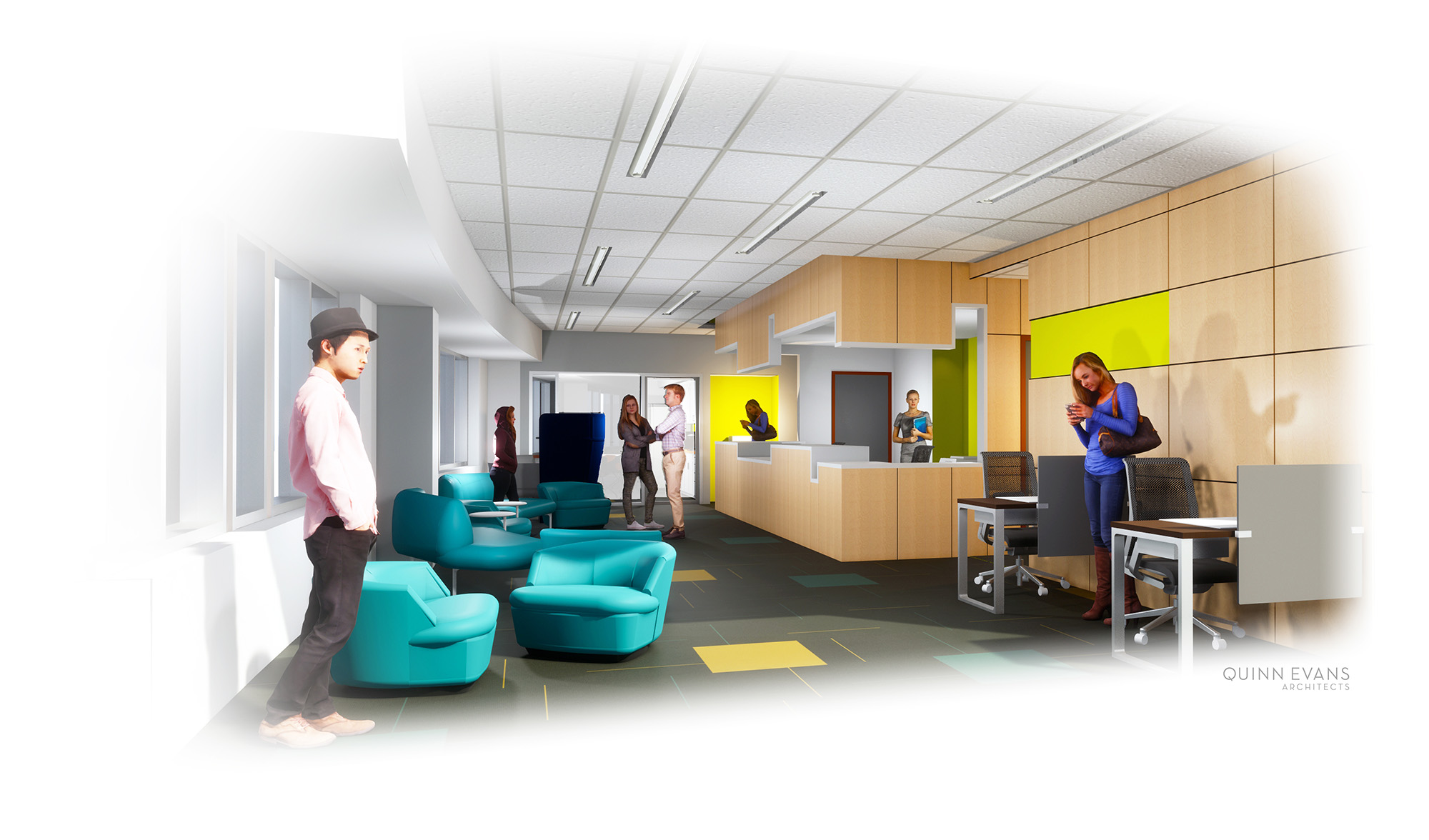Student Counseling Center Moving, Expanding as Part of SMC Campus Center Renovations
July 17, 2019 Lou Cortina
Relocation from smaller space in library aims to meet greater demand for mental health services.
Photo: Artist’s rendering of Student Counseling Center lobby
An ambitious project is underway at the SMC Campus Center designed to renovate and reimagine the Campus Life Services suite that aids University of Maryland, Baltimore (UMB) students. The relocation of the Student Counseling Center is paramount among the changes, moving from the fourth floor of the Health Sciences and Human Services Library (HSHSL) to the third floor of the Campus Center.
The reason for the project? In its simplest terms, the Student Counseling Center has outgrown its space in the HSHSL. But the changes represent a deeper meaning as well.
“We needed to find the Student Counseling Center space to facilitate the success of their services, but we also want to remove the stigma of mental health intervention and services,” says Bill Crockett, MS, RCRSP, executive director, Campus Life Services and the SMC Campus Center. “By bringing the Student Counseling Center into the Campus Center and giving it more visibility, it doesn’t mean that the services themselves are visible but that the presence is visible for those who’d like to use them.
“We emphasize the importance of well-being for students, so it’s all part of our mission to boost their well-being.”
According to Anna Borgerding, director of Campus Life Services facilities and special projects, demand for student counseling services has increased by about 20 percent during the last five years, necessitating a larger space. Emilia Petrillo, LCSW-C, executive director of the counseling center, says during this period a full-time licensed clinical social worker was hired to manage cases and psychiatrists’ weekly hours were increased from 25 to 32 hours a week to better meet students’ medication management needs.
The trend at UMB parallels an uptick nationwide in college students seeking mental health services. In a recent survey by the American Council on Education, 80 percent of college presidents indicated that student mental health has become more of a priority on their campus than it was three years ago, and 70 percent had allocated or identified additional funding to address the issue.
At UMB, instead of simply moving the counseling center into a larger physical area, University leaders made the relocation part of what Crockett called a “revisioning and repurposing” of the Campus Life Services suite.
Crockett says many college campuses are moving toward the concept of “integrative well-being,” which entails mental health, wellness, and recreation services being located in the same physical area and where interventions and solutions are offered to students in a coordinated way. “That meant revisiting the way we lay out our services in the building,” he said.
To that end, the third-floor Campus Life Services suite is being gutted and renovated to include the Student Counseling Center and other student services. A long bank of storage units used by student organizations will be moved to the lower level; various employees have been relocated in the suite or moved elsewhere in the Campus Center or to other buildings on campus; and the suite will have a more open design.
“The strategies are to have better synergy among the offices and improved technology and energy efficiency as well as to use natural light for more sustainable and effective delivery of services,” Crockett says. “We’re trying to leverage the opportunities as we see them.”
With such a project comes disruption to work spaces, and in an elaborate game of musical chairs, Borgerding says at least 65 employees have been moved — some twice — during the renovations. “We’ve tried not to move everybody in the same week, because that can be very difficult. There’s a lot of dominoes involved,” Borgerding says.
When the project is complete, the Student Counseling Center will be in what Borgerding calls “a more prominent place but not necessarily a prominent entrance,” so that students seeking services can maintain privacy. “They can just come to the Campus Center and go to the third floor, and they could be going anywhere on the third floor,” she says.
“Also, by being in the Campus Center, it allows the Student Counseling Center to more easily collaborate with other Campus Life Services departments to deliver programming opportunities for students — for instance, having ‘Healthy Selfie Week’ with our wellness staff and URecFit. So it’s all about collaboration, bringing these programs together to aid students.”
Among the other changes:
- International Student Services and the Center for Global Education Initiatives have been moved side-by-side to a wing on the third floor. “We are enclosing that space to make it feel like it has its own suite with a dedicated reception area,” Crockett says.
- The relaxation zone will relocate to a designated relaxation room, with more space, furniture, and direct natural light. “A lot of students really use that area to decompress, maybe take a nap and de-stress,” Borgerding says. “We also will be seeking input from students and the Wellness Hub on furnishings.”
- Educational Support and Disability Services’ Testing Center, where students who need testing accommodations can take exams, will remain in its current location in the lower level, and its services have expanded to include students from other UMB programs rather than just the School of Nursing as it did in a pilot program that began in spring 2017.
- All of the changes will occur on the third floor and lower level of the Campus Center — “The first floor, second floor, and event programming spaces on the third floor are staying untouched,” Crockett says — and the goal is to have the project completed by March 2020. And when it’s done, Borgerding says, “We will be coordinating with staff working in the spaces and students who utilize the spaces to program each area to benefit everyone.”
To learn more about the project and see a timeline, visit the link below.